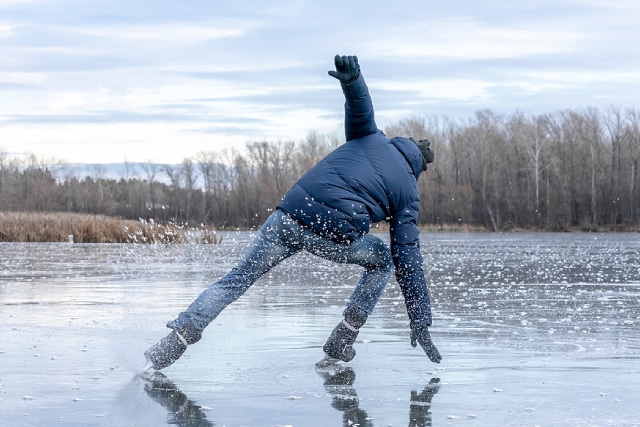The sensation of slipping on ice is a familiar experience for many people, especially during the winter months. While it may seem like ice is inherently “slippery,” there’s actually an interesting physics explanation behind this phenomenon. Ice’s slipperiness is tied to the principles of friction, molecular behaviour, and the unique properties of water. Let’s explore why ice is so slippery and how physics helps us understand this fascinating phenomenon.
The Role of Friction
Friction is a force that opposes the relative motion between two surfaces in contact. It occurs when the molecules on one surface interact with those on another, creating resistance. In most cases, friction works to slow things down or prevent motion entirely. For example, when you walk on dry pavement, the friction between your shoes and the ground provides the necessary grip to keep you stable.
However, when it comes to ice, friction behaves quite differently. The coefficient of friction (a measure of how much resistance there is to sliding) on ice is much lower than that on other surfaces like concrete or wood. This means that objects, including your feet, experience less resistance when they try to slide over ice.
Ice’s Molecular Structure
To understand why ice is slippery, we need to take a closer look at its molecular structure. Ice is a solid form of water, and water molecules are polar, meaning they have a positive and a negative charge. In the solid form, the molecules are arranged in a crystalline lattice structure, with each molecule hydrogen-bonded to others.
At temperatures below freezing, this lattice structure is stable, and the surface of the ice feels smooth to the touch. However, when pressure is applied to ice—such as when you step on it—the ice molecules at the surface undergo a phenomenon called “melting” due to the pressure exerted on them. This creates a very thin layer of liquid water on the surface, which reduces friction and makes the ice slippery.
The Pressure-Melting Effect
The idea that pressure causes ice to melt is known as the pressure-melting effect. This principle explains why ice is slippery, even when the temperature is well below freezing. When you step on ice, the pressure from your foot compresses the ice at the point of contact, causing a small amount of it to melt. This creates a thin film of water that acts as a lubricant, making it easier for your foot or any object to slide across the surface.
Interestingly, this is also why ice skaters can glide so effortlessly on ice. The pressure exerted by the blade of the skate is enough to cause the ice to melt slightly, creating a thin layer of water that reduces friction and allows for smooth movement. The skater’s speed and the design of the skate blade help maintain this thin layer of water, enabling the skater to glide effortlessly across the ice.
The Role of Temperature
Temperature plays a crucial role in the slipperiness of ice. At lower temperatures, the ice remains in its solid crystalline form, and the surface is smooth. However, even at these colder temperatures, there can still be a thin layer of liquid water on the surface due to the melting effect discussed earlier.
In slightly warmer conditions, the ice becomes even slipperier. As the temperature rises, more of the surface ice melts, increasing the thickness of the liquid layer and further reducing friction. This is why ice can become particularly treacherous during temperatures just above freezing—more liquid water forms on the surface, making it even easier to slip.
Exploring the Physics of Ice and Friction
The slipperiness of ice is an excellent example of how physics explains everyday phenomena. By understanding the molecular behaviour of ice, the pressure-melting effect, and how temperature affects friction, we can better appreciate why ice behaves the way it does. Whether you’re walking on ice during the winter or ice skating on a frozen pond, physics is at work, ensuring that friction plays a much smaller role on ice compared to other surfaces.
For those interested in learning more about friction, ice, and other fascinating physics concepts, physics tuition can provide valuable insights. Through structured lessons, you can deepen your understanding of the fundamental principles that govern our world and gain a stronger grasp of the science behind everyday phenomena.
Conclusion
Ice’s slipperiness is not just a quirky fact of nature—it’s a direct result of the way ice molecules behave and how pressure affects their structure. The pressure-melting effect, combined with the low coefficient of friction, makes ice an ideal surface for sliding.
If you’ve ever wondered why ice is so slippery or how forces like friction and pressure affect the world we live in, there’s so much more to uncover through dedicated physics tuition. At Tuition Physics, we take these everyday mysteries and turn them into learning opportunities—teaching the core principles of motion, energy, and molecular interactions in ways that are both accessible and exciting. Our expert tutors are passionate about helping students not only improve their grades, but also build the confidence to ask “why” and “how” in everything they observe. Whether you’re aiming for top marks or just love learning about how physics explains the world, Tuition Physics is here to support your journey every step of the way.
Contact us today for more information.


